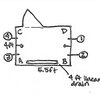About 5 years ago I had a contractor install a 1" copper service line into my basement (cement block foundation) from the meter vault out by the street. It was a new installation, about 100' in length, new meter, new tap by the water authority, etc. The line comes in approx 4' below grade with a hole punched thru the 9th course of block about 18" from the corner of the house. There are 2.5 courses of block above grade.
To this date I have not used the service (looks like the copper was a good investment!!). It was never turned on at the curb stop or the valve before the meter. The water authority people had told me that if they were to turn it on they wanted someone at home. As a precaution at the time, however I sweated a cap on the 1" line in the basement. We were and still are on well water.
The contractor did not patch the hole in the block or slip any kind of protective sleeve over the tube where it passes thru the foundation wall.
About 18 months after the installation there was an "accident" where when the farm field next to my house flooded with ice and snow and the ground was frozen for several inches; a torrent of water and soil/sand rushed into the basement once it found a path thru the frost and thru the hole surrounding the pipe (the hole is 3-4" diameter). I cleaned that up, about 20 5 gal buckets of dirt, threw it back in the hole outside.
Now 5 years later I want to connect to the line. I look into the hole from the basement and see a lot of rocks on the other side. I guess they were left behind when the sand washed in. Most were small and I removed away from the pipe from inside, but there is one big guy that looks like a piece of thick slate that is resting (very lightly) against the tubing. It might be something that was under a downspout to prevent erosion. I slipped a piece of protective plastic between the pipe and the rock and had a go at the rock with a big stone chisel and sledge but no luck in busting it up.
So I'm resigned to digging down on the outside and fixing it right. I started digging parallel to the foundation since there are large foundation plantings, (3 bushes) a few feet out from the house. Will this work or should I just rip out the bush and dig perpendicular to the house?
How long of a trench do you think I'll have to dig to get down to work at 4ft? Anything better to use than a long-handle pointed shovel; it is pure sand down there at 4ft except for any debris that washed in from the surface. Once I reach the pipe I plan to remove any rocks, slip a piece of 1.5" PVC over the copper for protection thru the block and then patch with mortar or some kind of redi patch. Do I have to patch from both sides and what is a good material to use? I imagine if I want to patch from the ouside I will have to do a lot of digging to get working space and reach the hole.
Any suggestions at this point would be appreciated.
PART 2: Do you think any water may have crept into the pipe over these 5-years from leakage past the curb stop and/or the valve before the meter. Is there some way I can tell if there is water in the pipe before I either un-sweat the cap or cut it off. I was thinking of putting a saddle valve near the end as a test just to see if there is any pressure inside. I looked at the valve in the meter vault and at the curb stop and I'm a little concerned because although they seem to be "closed" the valve handles are not exactly perpendicular to the piping. The tube extends about 18" into the basement, so I will probably want to shorten a little anyways. If there is water in the pipe how do I cope with this to sweat on an elbow or valve. Would the bread in the pipe trick work or do I need a special tool or fitting? I suppose with hindsight I should have got that valve on there right away when I knew everything was dry.
I had planned to start with an elbow, then a valve, then a draincock type of spigot then another valve and on to the house plumbing. I was going to flush the line thru a hose before connecting to the house cold water.

















serviceplumberman
hal_sOriginal Author
Related Discussions
Gaggenau Dealer says if I buy on line, warranty service a problem
Q
Size of line for main service at 1400 ft
Q
Replacing main water service line - copper? PE? PEX?
Q
What is best pipe for service line
Q
serviceplumberman